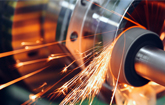ATLANTA, Dec. 12, 2023 /PRNewswire/ -- Novelis Inc. is a leading sustainable aluminum solutions provider and world leader in aluminum rolling and recycling.
Thought leadership:
"Lighter, Greener, Simpler – Aluminum Drives New Automotive Design Dynamic"
by Jamie Zinser, Vice President, Global Automotive, Xavier Varone, Global Technical Director and Don Whitacre, Director, Automotive Technical Development, Novelis Inc.
Automotive OEMs and the global network of essential materials and service providers that support the rapidly evolving auto industry have made great strides over the past decades in dramatically reducing the carbon footprint of their collective operations while also delivering tremendous performance benefits to those who purchase and use their products.
But we can all do better. We can all do more.
Making vehicles lighter, greener, and simpler to manufacture is critical to improving the features, functionality, and sustainability of the auto industry's internal combustion engine (ICE) models while also driving the growth of the increasingly robust market for battery electric vehicles (BEVs).
Aluminum is key to the success of this important mission.
Aluminum is the fastest-growing automotive material, according to the latest Ducker Carlisle 2023 North American Light Vehicle Aluminum Content and Outlook report. Pound for pound, kilo for kilo, no other material can match aluminum when it comes to delivering the strength, durability and low-carbon footprint demanded by today's increasingly innovative vehicle designs while also significantly reducing weight.
This makes transitioning to aluminum the most effective way to help both ICE vehicles and BEVs reach fuel/energy efficiency targets while helping drive down carbon emissions.
Novelis is Leading the Way
For more than 40 years, Novelis has been a leading global supplier of aluminum sheet to the auto industry, with automotive operations on all three of the auto-producing continents – Asia, Europe, and North America. Our automotive product portfolio includes high-performing alloys that are featured in more than 315 models on the road today, including the iconic Ford F-150 series, Jeep Wrangler, and Land Rover Defender. This deep experience gives us a unique perspective and a proven ability to heavily influence the performance, efficiency and sustainability of the automotive industry itself and the vehicles we help produce.
More importantly, as a purpose-driven company dedicated to sustainability, we have a social responsibility to do just that.
What We Know
Transportation makes up roughly 16% of total global greenhouse emissions, according to data from Climate Watch, the World in Resources Institute (2020). Passenger cars, trucks, buses, and other commercial and recreational vehicles constitute more than three quarters – 77% -- of all emissions from transportation, according to a 2023 report by Statista.
Accordingly, life cycle assessments have shown that the greatest potential to reduce the environmental impact of vehicles is to address the use phase. According to an Oakridge National Lab study, the use phase of an ICE vehicle accounts for up to 90% of the carbon emissions generated over its total lifecycle. When it comes to BEVs, the use phase contributes to approximately 70% of their lifetime carbon emissions, according to a recently published Alumobility Last Mile Delivery Vehicles study.
Aluminum is Lighter
Aluminum is lighter than steel while delivering greater specific strength, energy absorbing capacity, and longevity characteristics. Aluminum has a material density that is one third of steel, and lightweighting via aluminum typically generates a body-in-white (BiW) weight savings of more than 40% compared to a steel BiW. This means that you can replace 1 kilogram (kg) of steel with 0.6kg of aluminum with no reduction in performance.
But that's not all. This greater than 40% BiW weight saving is called primary mass reduction, which in turn generates significant additional opportunities for secondary mass reduction. For example, reducing the weight of the BiW means that the motors, motor controllers, batteries, wheels, tires and brakes can all be reduced in size and mass. When the mass of hang-on components, such as doors and hoods, is also reduced, the BiW can be made even lighter, leading to a second round of ancillary component weight reductions. Often, the magnitude of the secondary weight reduction can exceed 50% of the primary weight reduction. Ducker Carlisle's report identified key areas of growth for aluminum used in BEVs from 2022 to 2030 in terms of pounds per vehicle (ppv), such as battery housings (+37ppv), electric motor housings (+34ppv), doors (+8ppv) and sills/rockers (+4ppv), owing to aluminum's ability to help generate both primary and secondary weight savings.
To prove this, Novelis recently participated in a study conducted by the Alumobility consortium that modeled the design of an aluminum body for a fully electric last mile delivery van. The study showed that we could achieve a compounded 550kg weight savings with aluminum vs. the steel baseline. This weight savings triggered a battery size reduction from 69kWh to 63kWh, which represents a net saving of $770 per vehicle. This savings significantly offsets the extra costs of designing in the aluminum solution.
On top of the 40% weight saving, studies by Alumobility on the value of converting existing steel bodies into aluminum showed the potential to significantly reduce the part counts by 10% and the number of joints required by 20% when designing with aluminum. The design, which facilitated the reduction in manufacturing and assembly complexity by using a combination of aluminum sheet, castings, and extrusions, has no equivalent in steel.
These are just a few of the reasons the aluminum content of automobiles continues to grow from less than 130kg per vehicle at the beginning of this century to close to 220kg per vehicle today. We fully expect this growth rate to accelerate in the near term, at a compound annual growth rate of 6.4% from 2022 to 2026, with the rise of BEVs, according to Ducker Carlisle.
Aluminum is Greener
The weight reductions generated by the increased use of aluminum translate into lower energy use over the life of a vehicle. For example, reducing the weight of an ICE vehicle by 220 pounds (100kg) decreases fuel consumption by as much as 5% over the entire life of a vehicle. This same 220-pound weight reduction for a BEV translates into a reduction in energy needed to achieve the same range by approximately 3.2kWh, according to The National Renewable Energy Laboratory's FASTSim: Future Automotive Systems Technology Simulator.
As OEM's fleets continue trending toward larger vehicles, such as SUVs and trucks, aluminum sheet offers even greater vehicle efficiency and performance benefits that help automakers achieve lower emissions, longer battery ranges, and greater weight savings.
What does this mean for consumers? A weight savings of 450kg in a full-body aluminum automobile saves owners more than 6,000kWh of energy over the typical 140,000-mile life of a vehicle compared to those built with steel bodies. These energy savings amount to 60% of the average annual electricity consumption for a U.S. residential utility customer. There also is data to suggest a lighter vehicle creates less wear and tear on sub-systems, such as brakes and tires, resulting in lower maintenance costs to the vehicle owner.
These carbon emission reductions and consumer maintenance benefits can be achieved simply by using aluminum for hoods, doors, and battery enclosures. The energy savings – and the corresponding reductions in carbon emission – can reach up to 20% if the use of aluminum is expanded to the full body of the vehicle, according to the EDAG Silverado Body Lightweighting Final LCA Report.
Manufacturing with Aluminum is Simpler
For automotive OEMs and the network of innovative suppliers tackling the challenges facing the industry, closer collaboration earlier in the vehicle design process is a critically important step. Only by working together in a more tightly integrated fashion – from start to finish – will we succeed in leveraging our collective insight, technology, and automotive-specific experience to make it simpler for OEMs to design in aluminum.
Change in the auto industry is driving new paradigms of vehicle design, lightweighting and manufacturing efficiency. To help drive these new paradigms, we need to improve our collective understanding of the challenges we face and collaboratively develop the innovative solutions required to meet them.
That's where our automotive Customer Solution Centers come in.
As a vital contributor to the next generation of process innovation, materials engineering, and manufacturing technology solutions for the auto industry, Novelis operates automotive Customer Solution Centers (CSCs) in Stuttgart, Germany; Shanghai, China; and Detroit, Michigan.
Why We Do It
Novelis' global network of CSCs are designed to speed the development of innovative aluminum solutions for the automotive industry by collaborating with our OEM customers and other Tier 1 suppliers across the automotive value chain, beginning with the early vehicle concept and design stages. Through these centers, we work to maximize the incorporation of lightweight, high-strength, sustainable aluminum into new vehicles.
Our CSC in Metro Detroit features advanced automotive manufacturing equipment, such as a hot stamping press, computer-aided design software, and advanced visualization technologies that digitally model vehicle performance and safety scenarios. This CSC also contains a roll forming development line for exploring innovative solutions for battery enclosure frames, rockers, front longitudinal members, and various cross members. This capability enables Novelis researchers to work in conjunction with auto OEMs and others in the value chain to develop and test alloys and processes for this emerging alternative to extruded parts.
This center – like all Novelis CSCs – is fully staffed with the top experts in aluminum engineering and automotive manufacturing in the world.
The purpose of all Novelis CSCs is to create new aluminum solutions that optimize the design of critical vehicle applications, assess material behavior impacts on their performance, and develop optimum forming and joining technologies that fully reflect real-world manufacturing scenarios and processes used by automotive OEMs. This set of capabilities is unique in the aluminum industry and enables Novelis to create, develop and test new aluminum solutions for lighter vehicle designs, greener lifecycles, and simpler, more cost-effective manufacturing processes.
Where We Stand
Since launching our first CSC in 2018, Novelis has made several advancements in automotive design innovations using aluminum:
- Development of more efficient door design using high-forming aluminum alloys
- Development of critical strength-dominated structural components to compete with ultra-high-strength steel alloys
- Demonstration of optimized tempers for energy absorbing crash members that save weight and cost versus current extruded aluminum crash rails
- Design and prototype of aluminum-intensive battery enclosure solutions for electric vehicles
These are just a few of the most notable achievements we've made in conjunction with our major automotive OEM customers and supply chain partners as a result of the research and development conducted within our CSCs. Whether it's progressing innovative aluminum design solutions, researching the advantages of roll forming over the extrusion process, developing more sustainable alloys, or helping make electric vehicles even more efficient, Novelis is working hand-in-hand with our automotive customers across the globe every step of the way.
To find out more about how you can join us on our journey – to both benefit from and contribute to the new lighter, greener, simpler aluminum automotive design dynamic, contact us.
SOURCE Novelis Inc.

WANT YOUR COMPANY'S NEWS FEATURED ON PRNEWSWIRE.COM?
Newsrooms &
Influencers
Digital Media
Outlets
Journalists
Opted In





Share this article